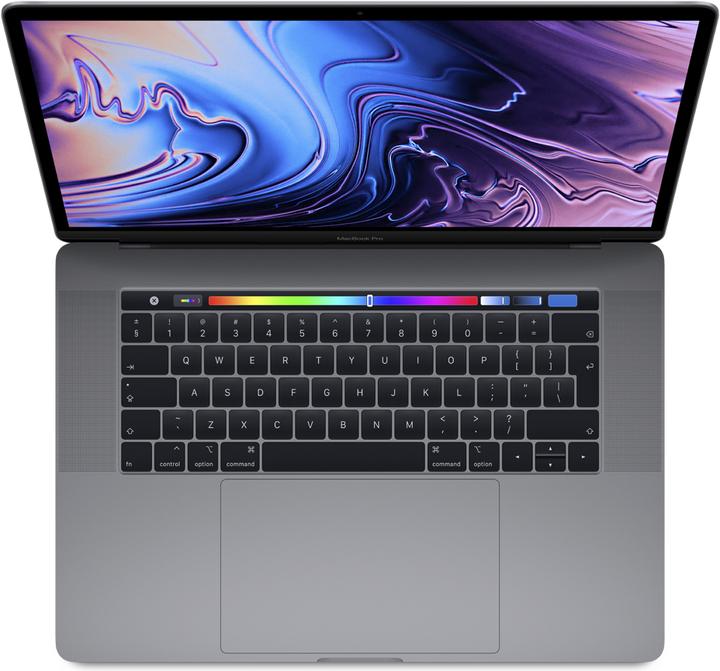
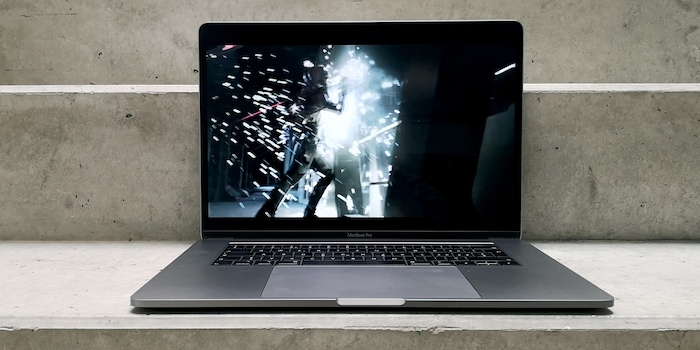
MacBook Pro mid-2018: great device with a few niggles
Each year, Apple skips a MacBook Pro series update. The latest to launch is the mid-2018 version and I’ve just put it to the test. Read on to find out if it’s worth the hefty price tag.
Who’d have thought it? You go on holiday for two weeks and come back to work to find the brand spanking new MacBook Pro waiting for you. I could think of worse scenarios. In that way I’m totally unlike my colleague Martin Jud, who’d rather do yoga with cows than roadtest a Mac. Thanks, Martin, for leaving all the fun for me.
But it’s not just any old version that’s sitting on my desk. Product management have left me the 3,199 franc model (price: 2 August 2018). That’s the fastest one you can get on digitec. If you want anything faster, you need to buy it direct from Apple. But then it starts to get really expensive. The most expensive configuration will set you back more than 7,400 Swiss francs (price: 2 August 2018).
Devices direct from Apple HQ in Silicon Valley have always cost more than those from competitors. Compared with the ZenBook Pro, which comes with similar components, my test MacBook cost 900 francs more.

What exactly is in my test device?
- Intel Core i7-8850H 2.6 GHz
- Radeon Pro 560X 4096 MB
- 16 GB 2400 MHz DDR4
- 512 GB SSD
- 15.4-inch Retina display 2880 x 1800 with 220 pixel per inch
- Touch bar with integrated fingerprint scanner
- Speakers, microphone and front camera
- Lithium polymer battery with 83.60 Wh
- macOS High Sierra
Design and ports
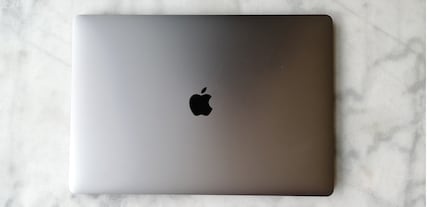
Since 2016, nothing has changed about the design. The casing is still made of aluminium, and it seems high-quality and sturdy. As you’d expect from Apple, they don’t add anything fancy for the sake of it. What has also stayed the same is the placement of the cooling fans. They’re still at the back of the MacBook, but as always, you don’t even notice them.
The device comes in at 1.83 kg, is 1.55 cm thick, 24.07 cm long and 34.93 cm wide. This puts it on a par with Windows notebooks.
In this model, Apple continues in its quest to save on ports. You can search high and low for a USB A connection but you’ll be looking in vain. The same goes for a card reader. Having said that, it’s not all bad news. You do get four Thunderbolt 3 ports that are also suitable for all USB C devices. And there’s still a headphone jack. But that’s your lot.
This is just Apple carrying on what it started in the 2016 range. As the owner of a 2017 MacBook Pro, I should probably already know that. But to this day I still can’t get to grips with the fact I always need to cart my hub around.
And that’s coming from me, someone who doesn’t even have a lot of peripheral equipment. I don’t want to think about how much a nuisance it must be for hardcore users trying to hook all their input and output devices up to a new MacBook Pro.
Don’t get me wrong. I get that Apple want to stay on brand and keep design as simple as possible. But when it gets to the extent that brand identity encroaches on the user experience, that’s when I’m not too pleased. If they’re charging a mighty 3,200 francs, I’d at least expect it to come with a hub.
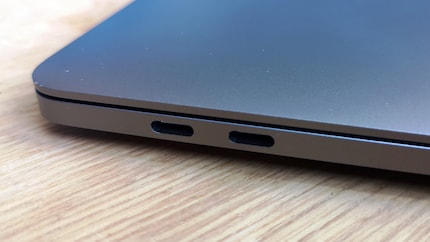
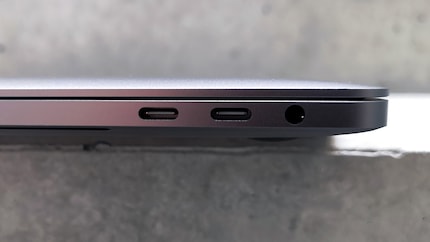
Ports are few and far between.
Display
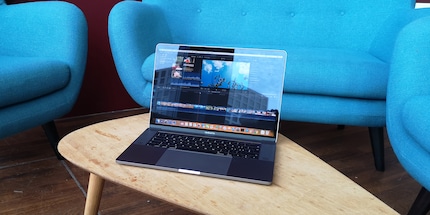
Behold the 2880 x 1800 pixel resolution retina display based on IPS technology with LED backlight. The glossy image looks great and should let you work with precision colours right out of the box. The MacBook Pro is perfect for graphics-intensive use.
Important side note: if that’s what you intend to use it for, make sure you switch off the true tone mode in the settings first. This automatically adapts the white balance for different light situations. While this might be ideal for office workers, it’s detrimental when you’re trying to edit photos or videos.
Touch bar, keyboard and trackpad
Included in the mid-2018 version is the touch bar that was introduced in 2016. You’ll have to decide for yourself if it makes any sense for you to use it. Personally, I think it’s pretty practical for navigating in Safari. But apart from that, my fingers don’t tend to gravitate towards it. Perhaps that’s because the touch bar is only compatible with certain applications. For instance, it doesn’t work in Chrome.
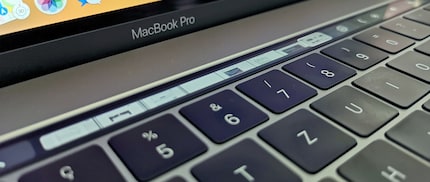
As usual, you activate the Siri button above the backspace button on the touch bar. The position of it means I’ve already pressed it a number of times by accident. Fortunately, you can remove this Siri shortcut by going to the keyboard settings. At least then I don’t get Siri babbling on at me. When I do yell impatiently, «I hate you, Siri», it now just replies with a simple, «oh, that’s a shame».
The fingerprint sensor integrated into the power button works seamlessly and gives you extra security while you use it. Sadly, the 2018 series doesn’t come with Face ID, so we’ll still have to hold tight for that.
In terms of keyboard, the latest MacBook Pro comes with the third generation of the butterfly keyboard. Since it was introduced in 2016, this keyboard has come under a deluge of criticism. There are two main issues. First, there’s the question of quality. According to reports, some keys suddenly stop working.
Then there’s the problem of faulty ergonomics. The hey drop is very short if not verging on non-existant. And the keyboard makes a racket when you type. At least Apple managed to improve the noise issue slightly with the latest butterfly generation. According to ifixit.com, there’s now a silicon layer under the keys. But I still have to say the keyboard is comparatively loud.
A nice side effect of the extra rubber suppressing the noise is that less dirt and dust is supposed to get under the keys. Of course, that’s not the real reason for the silicon layer. Personally, I’m not a fan of the butterfly keyboard either. Typing felt nicer on my 2011 MacBook Pro than on the 2017 or 2018 models.
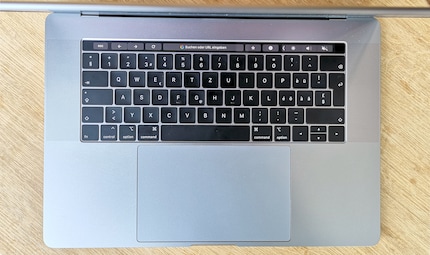
As I see it, the trackpad is one of the reasons for still buying a MacBook Pro. I love how it reacts and does lots of different things with different movements. At 16 x 10 cm, this trackpad is enormous. But believe it or not, it doesn’t get in the way when you’re typing. It’s the complete opposite of the miniscule strokes on the keyboard.
Speakers
What other manufacturers like to hide, Apple flaunts. The speakers in this MacBook Pro are on the left and right hand side of the keyboard. They’re not just there to be seen; they’re there to be heard. If you like to watch films on your laptop, you’re in for a treat. For notebook speakers, they deliver a clean sound. Even in loud action scenes, you can hear the voices clearly. This says it all: I’m yet to find comparable sound quality from notebook speakers for watching films.
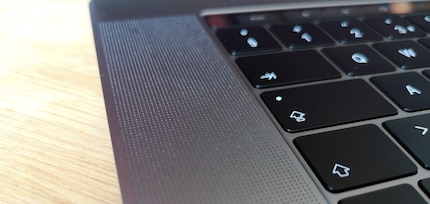
It’s not just film audio that’s great; sound quality on music is also impressive for a notebook. It’s only when you play songs really loud that the high notes get tinny. Even then, the middle tones and low notes still sound good.
Battery
The 83.6 Wh battery in the new MacBook is more than generous. Apple are quoting a mighty ten hours of battery life. I was quite a long way shy of that in my test. In a day’s normal use of word processing, surfing the net and streaming, my screen time only comes to around eight hours. Charging it up fully takes about an hour and a half.
But you expect more from us in these tests. After all, we’re here to see what these devices can do. That’s why I carried out various tests on the MacBook all at the same time. We want to know how long the laptop can hold out under constant load. I start by stressing the CPU with the yes command in the terminal.
While that’s running, I go on to test the RAM with the MemTest. To make sure the graphics card doesn’t feel left out, I let Cinebench R15’s OpenGL run. And last but not least, I run the Blackmagic Disk Speed Test.
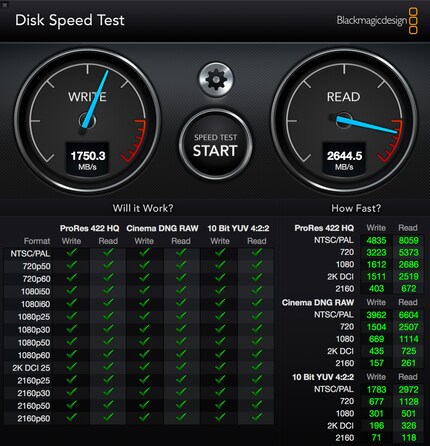
Here’s what happens: the MacBook immediately gets very loud and hot. The programme Fanny shows it has reached 65℃. But it feels a lot warmer than that. Within 50 minutes, there is 50% battery left. I start to worry about reducing the MacBook’s life expectancy if I carry on like this so I stop the test there and then. Having said that, lasting 50 minutes under constant load is a respectable result.
CPU
My test device is home to an Intel Core i7-8850H. Like all new MacBooks with a touch bar, this model now comes with an eighth generation Intel processor. They promise higher performance than previous versions.
In the benchmark Geekbench 4 CPU benchmark, my test device delivers values of 5,000 in the single core test and 20,000 in the multi-core test. This puts the MacBook Pro around 300 points above comparable predecessor models in the single core benchmark and 5,000 when it comes to multi-core.
The increase in performance isn’t significant in the single core test, but the MacBook makes up for it with an impressive result in the multi-core. This also comes down to the fact the MacBook from mid-2017 has a mere quad core processor with eight threads rather than the six core processor in the new machines with 12 threads. You’ll only notice this in processes that use several cores.
But for Apple it wasn’t all plain sailing. They had problems with cooling in the models fitted with i9-processors. That’s why the processor delivered comparably poor results and the issues were resolved in a system update. In the model I tested, I couldn’t spot any changes in the benchmarks as a result of the update.
Graphics card
Apple either builds a Radeon Pro 555X or Radeon Pro 560X into its 15-inch models. My test device has the 560X. In the Cinebench R15 OpenGL test the GPU reaches between 90 and 100 fps. As a result, it falls behind the GTX 1050, which you find in the Asus ZenBook Pro.
In Geekbench 4’s OpenCL benchmark the GPU manages between 60,000 and 65,000. That places it around 20,000 points higher than the Radeon Pro 560 used in the predecessor model. Unlike the results with the processor, the GPU shows a substantial performance increase.
Verdict
Is it worth switching to a new new MacBook Pro? Here’s the non-definitive answer you probably don’t want to hear: it depends.
If your old Pro model looks like it’s getting on a bit, buying a new model would certainly be worth it. Similarly, if you use your laptop for work or you’re an Apple disciple who always needs to have the latest product, this one is for you.
But if your old MacBook Pro is still working fine, you don’t necessarily need to make the switch. The increased performance wouldn’t be significant enough to warrant the purchase – and there hasn’t been a shake-up in the design either. Ever since 2016, Apple has preferred to focus on evolution rather than revolution.
However, I should say it’s not worth having expectations of massive leaps in performance. As I explained, my test device heated up fairly quickly and that’s reflected in performance. I hope Apple works on cooling systems in the next version. Given the trend for ever thinner and lighter portable devices, that’s something of a Herculean task. Let’s see what Apple comes up with. Maybe this will finally be the moment when Apple’s ideology of simple, elegant design gets in its way.
What else should you expect from this new MacBook Pro? You get everything you’ve come to expect from Apple: a high-quality finished product that’s incredibly reliable.
Of course, there are a few snags. There’s the butterfly keyboard for one. It still takes a lot of getting used to. I don’t mean it needs to have a key drop like on mechanical keyboards but a bit more would be appreciated. Only time will tell if the new silicon layer under the keys minimises problems.
The other issue is lack of options when it comes to ports. In this model, Apple continues to offer four Thunderbolt 3s or USB 3.1 C ports. If you want to use any other connectors or cards, you need a hub or a dongle.
There’s also the absence of Face ID as an extra security measure. Why Apple is (still) holding off building it into their MacBooks, I have no idea. To be fair, implementing Siri took them a while. And yet, they’ve had Touch ID on MacBook Pros with the touch bar since 2016. Welcome to 2003.
In spite of these niggles, the MacBook Pro mid-2018 is a very good device I’d recommend to anyone who can afford it and who isn’t totally Mac-averse.
From big data to big brother, Cyborgs to Sci-Fi. All aspects of technology and society fascinate me.